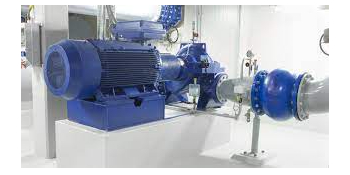5 Things to Know About IE5 SynRM Motors

February 1, 2022
Let ABB start at the beginning. What difference does the efficiency of an electric motor make to you and why should you care? The answer is that by using less energy we can help prevent climate change. Today, 45% of all electricity is converted into motion by motors in buildings and industrial applications. And generating electricity causes a significant amount of CO2 emissions, which cause global warming. So, if we want to reduce emissions and stop global warming, making motors more efficient is one of the best places to start. And in the world of motors, IE5 synchronous reluctance motors (SynRM motors) are the very best place to start.
The motors behind your everyday life
Whether we like it or not, almost everything we use in everyday life comes from some sort of factory. From food and water to clothes, everything is manufactured or processed. And wherever things are produced, there is a production line running continuously, 24 hours a day, 365 days a year. And every single production line in the world needs motors to keep it in motion and fans to cool it. This also applies to the water industry. Wherever you have a water supply, there are electric motors driving the pumps. Any industry you can think of needs motors. As a result, there are an estimated 300 million industrial electric motor-driven systems in the world.

If we could improve the efficiency of each of these motors by only a few percent, it would save a huge amount of energy. Synchronous reluctance motors offer the kind of big savings we’re looking for but it took many years of development to get this far. ABB looks at 5 things about synchronous reluctance motors.
1. The reluctance motor is an old concept
The reluctance motor was invented in 1838 and the first type was a switched reluctance motor, which used mechanical switches to control the motor speed. This switched mechanism meant that the motors could only rotate as fast as the switches could be operated. Back in the 1800s, when steam engines were still in vogue, this was a very slow speed. Over time the switching methods improved, however the motors still had drawbacks, including inconsistent rotation speed due to torque ripple.
2. The first synchronous reluctance motor was invented in 1923
In theory, synchronous reluctance motors promised much more consistent rotation speeds than switched motors because their rotation was synchronous with the frequency of the supply current. However, the technology for accurate control didn’t exist at the time so the motors couldn’t be operated effectively. It took almost 90 more years for the right control technology to become available.
3. Synchronous reluctance motors rely on variable speed drives to work
Variable speed drives use sophisticated solid-state power electronics and software to control the frequency of the motor supply current very precisely, switching it thousands of times per second. This gives variable speed drives the ability to drive synchronous reluctance motors very efficiently, maintaining exactly the right speed and power of rotation.
4. ABB introduced the first modern synchronous reluctance technology to the market
In 2004, engineers at ABB realised that their variable speed drive technology had the potential to run synchronous reluctance motors successfully. In 2011, after years of research, testing and development, ABB finally unveiled their new SynRM motor-drive packages at the Hannover Fair, in Germany. These new motors were designed from the beginning to be used as a package together with variable speed drives. This ensures optimum efficiency, accurate motor control, excellent reliability and a long product life-time. Believe it or not, product life-time matters. In some industries, where production is non-stop, they have to replace their motors every three to four months.
5. IE5 motors are the most energy efficient type of motors available
ABB now offers SynRM motor-drive packages with the IE5 ultra-premium energy efficiency class for the motor. This means that ABB offers the best available technology for motor efficiency. To give you an idea of the difference this could make to global energy use, most industrial motors currently have an IE3 efficiency class. ABB’s IE5 SynRM motors offer up to 40% lower energy losses compared to IE3 motors, as well as significantly lower energy consumption and CO₂ emissions.
Save money and save the planet
In business terms, SynRM technology can save a lot of electricity and therefore money per year. In environmental terms, it can also lead to a significant reduction in CO2 emissions. The technology to make a difference is here, now. We just have to decide to use it. Join the Energy Efficiency Movement and let’s make the world more energy efficient.






